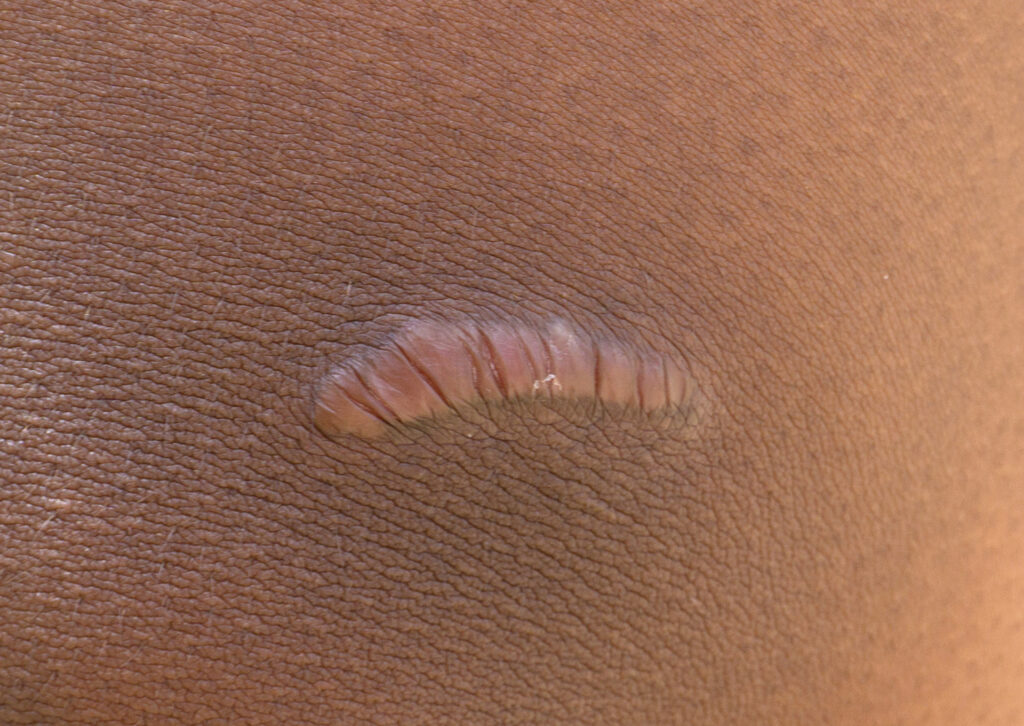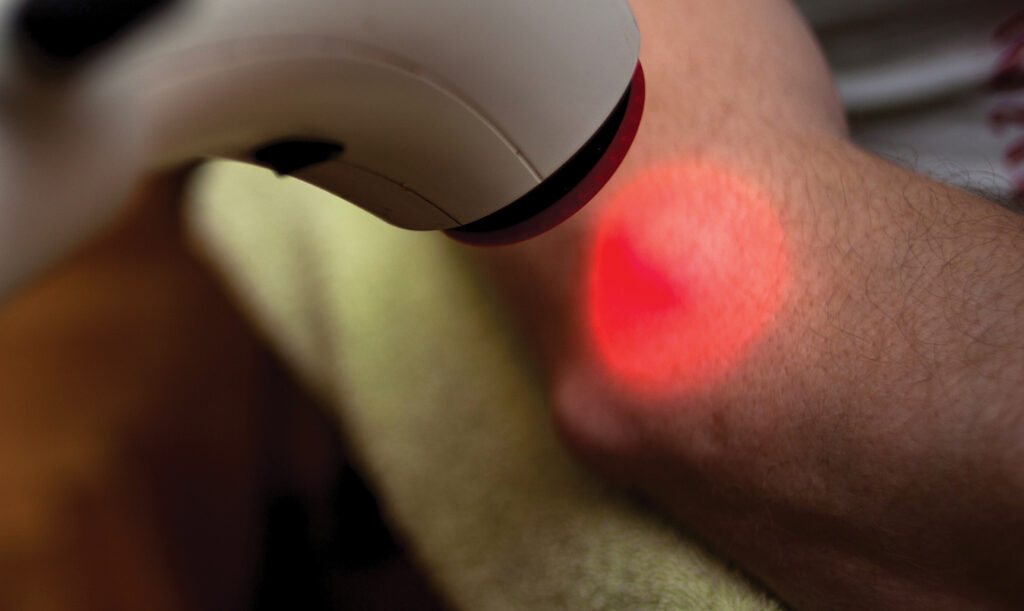By Lisette Hilton | Reviewed by Jared Jagdeo, MD, MS
Treating keloid scars can be tricky. Perfect outcomes are elusive and multiple treatments are the norm. Dermatologists can achieve optimal outcomes and high patient satisfaction if they use the right techniques, according to Jared Jagdeo, MD, MS, Associate Professor of Dermatology at SUNY Downstate Medical Center in Brooklyn, New York.

Dr. Jagdeo presented on keloid management in September at the virtual Skin of Color Update 2020, offering pearls and his take on promising therapies in the pipeline.
Pearl 1: Use cryotherapy before intralesional Kenalog injection (ILK)
One of the challenges with treating keloids is they are firm, making it difficult to inject them.
“One of the pearls that I learned from Dr. Charles McDonald, who was the founding chairman of Brown Medical School Department of Dermatology, is to gently paint the keloid with cryotherapy, or liquid nitrogen,” Dr. Jagdeo said.
Dr. Jagdeo sprays a diffuse stream of liquid nitrogen to gently freeze the keloid, waits about 30 seconds to allow the keloid to thaw, then repeats the process before injecting the scar. Cryotherapy softens the keloid and makes it more amenable to treatment injections.
Pearl 2: Use a large-gauge needle for keloid injections
Dermatologists often use a small 30-gauge needle to inject keloids. But Dr. Jagdeo typically recommends using a 25-gauge or 22-gauge needle. The larger gauge makes it easier for medication to enter the keloid and helps improve comprehensive keloid treatment.
Pearl 3: Use personal protective equipment (PPE) while injecting keloids
Most dermatologists are using PPE during the COVID-19 pandemic, but there is another reason to wear PPE when injecting keloids.
“There is a lot of pressure within the keloid. When you inject the anti-keloid medication, the medication can spray back onto the injector,” Dr. Jagdeo said. “By using PPE, especially gloves, facemasks, and eye protection, it helps keeps us safe while providing the best care to our patients.”
Pearl 4: Set patient expectations
Dermatologists should let keloid patients know they likely will need multiple treatments—usually at least 4 to 6 to improve the keloid dramatically. Treatment can take a while. And keloids can return.
Treatment results in improvement but not perfection.
“Aesthetically, one of the things that I let patients know is the keloid will never look like regular, normal skin. They can expect it to be flatter, less itchy or symptomatic, but it is unlikely that it will look perfect,” he said.
Pearl 5: Consider carbon dioxide (CO2) laser-assisted drug delivery
Depending on the setting, CO2 laser therapy can safely decrease inflammation and pigmentary change post-laser and decrease keloid size, according to Dr. Jagdeo.
He recommends applying triamcinolone ointment immediately post fractionated ablative laser therapy to deliver medication to keloid fibroblasts.
“Best results are achieved over a series of treatments spaced at least 1 month apart per treatment,” he said. For skin of color patients, I recommend waiting at least 6 weeks between treatments to allow for the epidermis to heal before the next treatment.”.

CO2 laser-assisted drug delivery helps dermatologists achieve optimal outcomes. Here, too, dermatologists should let patients know that they may need multiple treatments over a year or longer. One of the challenges of providing the treatment is dermatologists must have a fractionated CO2 laser, he said.
In a study published in 2015 in the Journal of Drugs in Dermatology (https://jddonline.com/articles/dermatology/S1545961617P0925X), Dr. Jagdeo and coauthors reported on a 39-year-old African-American man (Fitzpatrick skin type VI) with a 10-year keloid history who was successfully treated with 8 sessions of fractionated CO2 laser immediately followed by laser-assisted delivery of topical triamcinolone acetonide ointment.1
Emerging treatments
An emerging keloid treatment that excites Dr. Jagdeo is the use of light-emitting diode (LED) red light technology.
“We have pioneered this treatment using Omnilux technology, which is the best LED light on the market with the most power density and clinical trials and data supporting the technology’s use,” he said. “We have been using some of their handheld LED arrays for keloid treatments, and Omnilux has full panel arrays that are either mountable to a wall or placed on a trolley.”
Dr. Jagdeo has authored research showing LED red light treatment helps decrease molecular and other factors associated with keloid scarring, decreases collagen, and can melt away keloids.
“It is phenomenally impressive,” he said “Some of the things that are nice about it is that it is noninvasive, there is no downtime and no recovery time, it is relatively inexpensive and easy to administer, and is combinable with other treatment options. It can be done at home or at the dermatologist’s office.”
In a study published in 2015 in Dermatologic Surgery, researchers irradiated primary keloid-derived human skin fibroblasts using LED red light panels (https://insights.ovid.com/pubmed?pmid=25485805). The researchers concluded, “Light-emitting diode-generated red light can inhibit keloid fibroblast proliferation in a dose-dependent manner without altering viability. Light-emitting diode-generated red light has the potential to contribute to the treatment of keloids and other fibrotic skin diseases and is worthy of further translational and clinical investigation.”2
Clinical trials on LED therapy and scar prevention are ongoing, Dr. Jagdeo said.
Keloid fibroblast proliferation and function involve microRNA, he said. And microRNA is an emerging option in keloid treatment.
“If we can selectively increase or modulate microRNA into a favorable milieu, then we might benefit and improve keloids. This is on the horizon,” he said.
In his study “The role of microRNAs in skin fibrosis,” published 2013 in the Archives of Dermatological Research (https://link.springer.com/article/10.1007/s00403-013-1410-1), Dr. Jagdeo and coauthors wrote, “In the treatment of skin fibrosis, anti-fibrotic miRNAs may be upregulated using mimics and viral vectors. Conversely, profibrotic miRNAs may be downregulated by employing anti-miRNAs, sponges, erasers, and masks. We believe that miRNA-based therapies hold promise as important treatments and may transform the management of fibrotic skin diseases by physicians.”3
Botulinum toxin A is yet another potential therapy option, Dr. Jagdeo said.
“There is a lot of opportunity to use botulinum toxin therapy to treat scars. It relaxes some of the tension on the scar and helps decrease some of the factors associated with skin scarring. It’s safe but expensive,” he said.
Dr. Jagdeo and coauthors reviewed 11 basic science articles involving botulinum toxin A treatment of keloids and hypertrophic scars and published their findings in 2018 in Dermatologic Surgery (https://insights.ovid.com/pubmed?pmid=29401161). Studies suggest botulinum toxin A might reduce skin fibrosis by decreasing fibroblast proliferation, modulating the activity of transforming growth factor-β, and reducing transcription and expression of profibrotic cytokines in keloid-derived and hypertrophic scar-derived dermal fibroblasts. The neurotoxin might modulate collagen deposition but the evidence on specific mechanisms of action is lacking, according to the study.4
In the end, keloid management is complicated.
“Experts should be in control of keloid management. Skills needed include surgical removal, injection techniques, laser adjuvant treatments, and expecting the unexpected,” said Dr. Jagdeo.
References:
- Kraeva E, Ho D, Jagdeo J. Successful treatment of keloid with fractionated carbon dioxide (CO2) laser and laser-assisted drug delivery of triamcinolone acetonide ointment in an African American man. J Drugs Dermatol. 2017;16(9):925-927.
- Mamalis A, Jagdeo J. Light-emitting diode-generated red light inhibits keloid fibroblast proliferation. Dermatol Surg. 2015;41(1):35-9.
- Babalola O, Mamalis A, Lev-Tov H. et al. The role of microRNAs in skin fibrosis. Arch Dermatol Res. 2013;305:763-776.
- Austin E, Koo E, Jagdeo J. The cellular response of keloids and hypertrophic scars to botulinum toxin A: a comprehensive literature review. Dermatol Surg. 2018;44(2):149-157.
Disclosure: Dr. Jagdeo received National Institutes of Health funding to study LEDs for keloid prevention and treatment. He is on the advisory board for Global Med Tech and is a consultant for UV Biotek.


